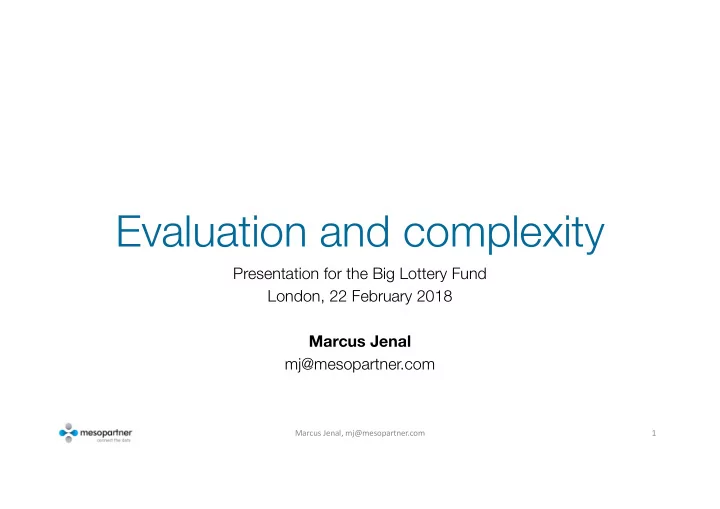

Evaluation and complexity Presentation for the Big Lottery Fund London, 22 February 2018 Marcus Jenal mj@mesopartner.com Marcus Jenal, mj@mesopartner.com 1
Different types of systems Let’s watch a short video … • Dave will be talking about three types of systems – chaotic, ordered and complex. • Pay close attention to the strategies he suggests using in each of these systems. Marcus Jenal, mj@mesopartner.com 2
Different types of systems What are the general strategies employed in each situation? In what system do you see your evaluation happening? Marcus Jenal, mj@mesopartner.com 3
Exercise With your colleagues, quickly brainstorm about 10 different issues connected to your evaluations, write them on sticky notes Ø Decisions, processes, methods, questions, struggles Examples: • Calculating necessary sample size • Travel booking • Moderation of a multi-stakeholder workshop • Ensuring evaluation results uptake • Getting expenses refunded Marcus Jenal, mj@mesopartner.com 4
Cynefin Not everything is complex! Marcus Jenal, mj@mesopartner.com 5
ORDERED COMPLEX Repeated actions do • not lead to same Multiple right answers to • results a problem • Evidence supports Good practice • competing The same action • hypotheses always leads to the • Constraints are same result. shifting Solutions are either • • Emergent practice known or can be found through analysis or Everything can • expertise. happen Options are • No constraints • constrained and • Novel practice constrains are fixed One right answer • to a problem Best practice • CHAOTIC Marcus Jenal, mj@mesopartner.com 6
Cynefin Emergent Practice Good Practice COMPLEX COMPLICATED DISORDER CHAOTIC OBVIOUS Novel Practice Best Practice Marcus Jenal, mj@mesopartner.com 7
Exercise Draw a Cynefin framework on a flipchart on your table and sort your sticky notes into the five domains! Add these if you don’t have 10: • Calculating necessary sample size • Travel booking • Moderation of a multi-stakeholder workshop • Ensuring evaluation results uptake • Getting expenses refunded • Measuring change in attitudes of people • Terrorist attack in the evaluation area Marcus Jenal, mj@mesopartner.com 8
Some theory Complex Adaptive Systems Marcus Jenal, mj@mesopartner.com 9
Complex Adaptive Systems • Large number of actors that interact dynamically • Adaptive strategies • Rich set of interactions leads to • high levels of interdependency • non-linear effects • feedback loops Marcus Jenal, mj@mesopartner.com 10
Emergence Emergent structure • Two types of interdependency: • between individual agents • between agents and emergent structure • Interdependencies create continuous dynamic adaptation Individual interactions Marcus Jenal, mj@mesopartner.com 11
A brief reflection Think back to the community you grew up in … In reflection with your neighbour, answer these three questions: • What are specific characteristics of that community that made the community that particular community and not any other? What made it unique? • What things you did were enabled through the community and its uniqueness? • What things you wanted to do were constrained by the community? Marcus Jenal, mj@mesopartner.com 12
Conceptualising complex systems Source: Acaroglu, L. 2017. Tools for Systems Thinkers: 7 Steps to Move from Insights to Interventions. Marcus Jenal, mj@mesopartner.com 13
Dynamics in complex systems: attractors • Embody a set of coherent values and beliefs • Encode specific behavioural norms • Modulate how new information is processed • Define a systems’ disposition Source: resalliance.org Marcus Jenal, mj@mesopartner.com 14
A simple example Source: Westley, F., et al. (2011) Tipping Toward Sustainability: Emerging Pathways of Transformation. Royal Swedish Academy of Sciences 15 Marcus Jenal, mj@mesopartner.com
Constraints • Constraints can be governing or enabling • Define what is possible or perceived to be possible – or enable things to be possible • Can be physical or social • Define a system’s propensities Marcus Jenal, mj@mesopartner.com 16
Causality in complex systems The structure of a CAS gives it a disposition and propensity for change There is no predictable causality BUT: there is retrospective coherence Marcus Jenal, mj@mesopartner.com 17
Discussion: Implications for Evaluation • What does it mean for evaluation that behaviour in CAS is not predictable? • What does it mean for evaluation that objectives and causality cannot be predefined in CAS? • How can evaluations be designed to still deliver insights for implementers and funders? Marcus Jenal, mj@mesopartner.com 18
Exploration and learning- based management Evaluation approaches: Developmental evaluation • Principles-based evaluation • Outcome-based • Use of timelines and vector management, results-based COMPLEX COMPLICATED targets payments Evaluation approaches: • Logframes Results chains • CHAOTIC OBVIOUS Marcus Jenal, mj@mesopartner.com 19
Thank you! Marcus Jenal Contact: mj@mesopartner.com Website: www.mesopartner.com Blog: www.jenal.org Marcus Jenal, mj@mesopartner.com 20
Recommend
More recommend